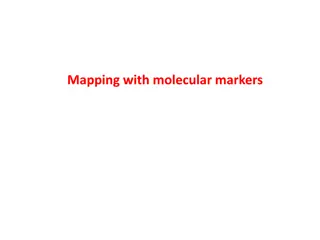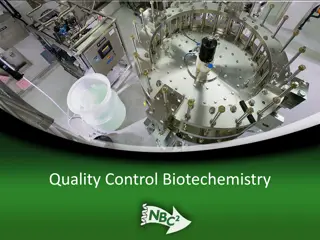Bacterial Biochemical Identification Tests in Microbiology
Understand the significance of biochemical tests like the Triple Sugar Iron Agar Test (TSI) and the IMViC Test for identifying enteric bacteria. Learn about indole production, methyl red test, and other methods used in bacteriology.
5 views • 17 slides
Planning Your Flow Cytometry Experiment: Building a Staining Panel
For successful flow cytometry experiments, it is crucial to plan your staining panel carefully by selecting appropriate markers and antibodies. Determine the goal of your experiment, research historical data for similar experiments, and choose markers specific to your cell type. Utilize resources fo
0 views • 19 slides
Enhancing Your Writing: The Power of Discourse Markers
Explore the importance of discourse markers in writing, such as linking words, sequencing words, illustrating phrases, cause and effect indicators, comparing terms, qualifying conjunctions, contrasting transitions, and emphasizing expressions. Understand how these tools help create cohesion, guide r
2 views • 10 slides
SRAP Markers: Feasible Tool for Invasion Genetics of Freshwater Fish
Molecular tools, like Sequence-Related Amplified Polymorphism (SRAP) markers, play a crucial role in studying invasion genetics of freshwater fish. SRAPs offer a reliable and efficient way to assess genetic diversity and variations in non-native species, aiding in population genetics studies of inva
1 views • 5 slides
Understanding Genetic Markers in Molecular Mapping
Genetic markers play a crucial role in gene mapping within molecular biotechnology. They are fragments of DNA associated with specific genomic locations, aiding in identifying DNA sequences and analyzing genetic variation. Various types of genetic markers such as RFLP, SSR, and SNP offer insights in
1 views • 26 slides
Understanding Biochemical Mechanisms of Drug Action Against Parasites
Parasitic protozoa cause devastating diseases in humans and animals, and chemotherapy is the primary defense. Drug resistance is a challenge, and prevention is crucial. Modern tools aid in studying genetic and biochemical aspects, targeting the parasite selectively. Drugs act by interfering with spe
1 views • 15 slides
Understanding Aging Process from a Biochemical Perspective
Biochemistry and Molecular Biology play crucial roles in understanding the aging process, focusing on the biochemical basis of life, the basis of health, major causes of diseases, and theories of aging. Aging is described as the accumulation of damage due to reactive oxygen species, with theories en
2 views • 11 slides
Understanding Biochemical Tests for Bacterial Identification
Explore the importance of biochemical tests like Triple Sugar Iron Agar and IMViC in identifying enteric bacteria. Learn about indole production and the Methyl Red test, essential in distinguishing bacterial species based on their metabolic activities. Discover how these tests aid in diagnosing food
2 views • 17 slides
Understanding Biochemical Markers of Myocardial Infarction
This lecture covers the criteria for diagnosing myocardial infarction (MI), features of ideal MI markers, the significance of plasma marker changes, and properties of markers such as cardiac troponins, creatine kinase, and myoglobin. It also discusses the new markers used for diagnosing MI and provi
1 views • 29 slides
Understanding Enzymes: The Key Catalysts in Biochemical Reactions
Enzymes are biological catalysts that play a crucial role in various life processes by speeding up chemical reactions. They are specific, protein-based molecules that lower the activation energy required for reactions, ensuring proper metabolism and efficiency in living organisms. Factors like pH, t
1 views • 46 slides
Exploring the History of Waymarkers: From Roman Milestones to Modern Signs
Delve into the fascinating world of waymarkers, from their significance in guiding travelers in the past to their evolution into modern signposts. Discover the importance of milestones, fingerposts, and guideposts, and learn how these markers have shaped our journeys throughout history. Explore the
0 views • 8 slides
Understanding the Triple Sugar Iron Test in Biochemical Analysis
The Triple Sugar Iron Test (TSI) is a crucial biochemical test used to differentiate gram-negative enteric bacilli based on their carbohydrate fermentation and hydrogen sulfide production. By examining color changes, gas production, and precipitate formation, microbiologists can interpret TSI result
2 views • 31 slides
Understanding Regulatory Enzymes in Biochemical Pathways
Regulatory enzymes play a crucial role in controlling the activity of biochemical pathways by responding to the presence of specific molecules. They regulate the pathway's activity, ensuring that products are produced in the required amounts at different times. This article delves into the significa
5 views • 22 slides
Predictive Performance of CSF A1-42 and Tau on Cognitive Decline and Dementia Progression
Analysis conducted at the Perelman School of Medicine, University of Pennsylvania, evaluated the predictive performance of cerebrospinal fluid markers A1-42, t-tau, and p-tau181 on cognitive decline and progression to dementia. The study included 2401 ADNI1/GO/2 CSF samples from individuals across d
0 views • 19 slides
Guidelines for Question Setters and Markers in English Class Eight
Today's lesson focuses on providing guidelines for question setters and markers in English class eight. The lesson emphasizes the importance of hygiene for good health and well-being, touching on topics such as cleanliness, maintaining a clean environment, and personal hygiene practices like bathing
0 views • 31 slides
Affinity Chromatography: A Breakthrough in Biochemical Research
Affinity chromatography, developed in the 1930s by A. Wilhelm Tiselius, is a vital technique for studying enzymes and proteins. It relies on the specific affinity between biochemical compounds and utilizes matrices like agarose for binding sites. Ligands such as amino and hydroxyl groups play crucia
1 views • 27 slides
Colorectal Cancer Projects Overview
This document outlines two projects conducted by the GI Collaborative Group focused on detecting and monitoring colorectal cancer using plasma protein markers and ctDNA/aberrantly methylated DNA markers. Project 1 aims to develop a panel of plasma biomarkers for the detection of adenomas and CRC, wh
0 views • 7 slides
Explore Membership Benefits with the Biochemical Society
Elevate your career with the Biochemical Society membership offering various benefits like grants, recognition awards, and cost-saving opportunities for attending events and conferences. Members enjoy access to prestigious journals and free secretariat services for hosting successful conferences. Jo
0 views • 11 slides
Role of REG3 and I-FABP in HIV-Related Gut Permeability and Inflammation
This presentation highlights the significance of Regenerating Islet-Derived Protein-3 (REG3) and Intestinal Fatty Acid Binding Protein (I-FABP) in microbial translocation, inflammation, and reservoir size in individuals living with HIV. REG3 and I-FABP serve as markers of gut epithelial damage and p
0 views • 7 slides
Russophonism in Flux: Language Practices and Identities of Russian-Speaking Migrants in the UK
Explore the evolving dynamics of Russophonism among Russian-speaking migrants in the UK, highlighting how language practices serve as cultural markers, fostering community ties, and stimulating creativity in multilingual contexts. The discussion delves into linguistic creativity, translingualism, an
0 views • 14 slides
Microbiology Biochemical Tests for Bacterial Identification
Learn about important biochemical tests used in medical microbiology, including the Coagulase test for Staphylococcus aureus, the Catalase test for enzyme detection, and the Oxidase test for electron transport chain identification. Detailed methods and result interpretations are provided for each te
0 views • 17 slides
Neurological Complications of Lyme Disease: Symptoms and Markers
In patients with Lyme disease, various neurological complications can arise, including inflammation of brain tissues, cranial nerves, and membranes around the brain. Symptoms range from headaches and neck stiffness to cognitive changes, mood swings, and sensory numbness. Specific markers, such as el
0 views • 24 slides
Project on Market-Class Specific Markers in Beans
This project, funded by the USDA National Institute of Food and Agriculture, focuses on identifying market-class specific markers in various types of beans. Through the use of polymorphic SNPs and indel markers, the project aims to enhance understanding of genetic variations in different bean variet
0 views • 17 slides
Using Ensembl SNP Data to Generate KASP Markers with PolyMarker
Welcome to PolyMarker! This tool allows you to design your own primers or download pre-designed primers for SNP data from Ensembl. You can create KASP markers by uploading your .csv file containing SNP information, aligning parental sequences, and analyzing SNP markers found using Biomart. Understan
0 views • 13 slides
Biochemical Quality Control Processes in Biotechnology
Quality control in biotechnology involves monitoring and regulating the levels of various components and impurities throughout the production process. Common methods of removal or purification include chromatography, filtration, and extraction. Scale-up considerations include changes in utility requ
0 views • 31 slides
Understanding G6PD Deficiency Hemolytic Anemia: Biochemical Basis and Implications
G6PD deficiency hemolytic anemia is an inherited condition characterized by reduced levels of glucose-6-phosphate dehydrogenase (G6PD), leading to impaired production of NADPH. This deficiency affects the Pentose Phosphate Pathway (PPP) and can result in oxidative stress, causing damage to DNA, prot
0 views • 18 slides
Understanding Cortisol and Cushing's Syndrome: Biochemical Insights
This content delves into the physiological and biochemical aspects of cortisol, diagnostic algorithms for Cushing's syndrome, and the interpretation of laboratory and radiological investigations for diagnosis. Explore the adrenal gland's anatomical features, the HPA axis, and glucocorticoid function
0 views • 16 slides
Correlation of Placental Growth Factor Markers with Clinical Outcomes in Suspected Pre-Eclampsia Patients at Maidstone and Tunbridge Wells
Study examines the correlation between placental growth factor markers and clinical outcomes in suspected pre-eclampsia patients at Maidstone and Tunbridge Wells. It explores the diagnostic challenges, diagnostic issues, PET ratio test, and NICE guidelines. Objectives include validating marker appro
0 views • 19 slides
Biochemical Methodology 530 - Lactate Dehydrogenase Extraction and Purification Experiment
This course focuses on the extraction and purification of lactate dehydrogenase (LDH) using a series of procedures involving tissue preparation, centrifugation, and ammonium sulfate precipitation. The methodology includes detailed steps from preparing the extraction buffer to isolating LDH in differ
0 views • 10 slides
Breast Cancer Research Projects Overview
Ongoing breast cancer research projects focusing on biomarker validation, new team initiatives, and imaging advancements are detailed. Notable efforts include the investigation of triple-negative breast cancer markers, benign breast disease progression markers, ER+ and HER2+ biomarkers, and breast c
0 views • 9 slides
Early Detection and Monitoring of Colorectal Cancer using ctDNA and Methylation
Blood tests for colorectal cancer (CRC) screening can enhance compliance and options for testing. Markers like ctDNA and aberrantly methylated genes provide potential for early detection and monitoring of CRC recurrence. By combining these markers in plasma samples processed similarly, a more effect
0 views • 36 slides
Understanding Biochemical Experiments and Blood Components
This content delves into various aspects of biochemical experiments, including qualitative and quantitative methods for substance identification and concentration measurement. It also covers the use of a spectrophotometer and different bodily fluids for analysis. Additionally, it explores the compon
0 views • 20 slides
Biochemical Aspects of Lipid Digestion by Dr. Amr S. Moustafa
This lecture by Dr. Amr S. Moustafa covers the biochemical aspects of lipid digestion, including the process, organs involved, enzymes required, and end products. It discusses the assembly, metabolism, and fate of chylomicrons, as well as the clinical manifestations of diseases related to defective
0 views • 31 slides
Industrial, Microbiological & Biochemical Analysis - Course Overview by Dr. Anant B. Kanagare
Dr. Anant B. Kanagare, an Assistant Professor at Deogiri College, Aurangabad, presents a comprehensive course on Industrial, Microbiological, and Biochemical Analysis (Course Code ACH502). The course covers topics such as Industrial Analysis, Microbiological Analysis, and Biochemical Analysis. Dr. K
0 views • 16 slides
Chemistry 1151K Course Overview and Chapters Summary
Upon completion of the CHEM 1151K course, students will apply the scientific method to investigate chemical questions in allied health, utilize dimensional analysis to solve quantitative problems, communicate effectively using chemical terminology and symbols, describe the behavior of biochemical so
0 views • 44 slides
Managing Display of Information in TMG
Learn how to control the display of information in TMG software by using exclusion markers. Exclusion markers help you suppress certain fields in order to make space for other important information to be viewed, control export to GEDCOM files, and manage printing preferences. These markers can be ap
0 views • 20 slides
Department of Biochemical Sciences at MONA: Biochemistry Section, Academic Staff, Research Highlights, and Courses Offered
Explore the prestigious Department of Biochemical Sciences at MONA, specializing in Biochemistry, Anatomy, Physiology, Pharmacology, Physical Therapy, and Dentistry. Learn about the dedicated academic staff, research highlights in medical and plant biochemistry, and offered degrees. Discover the com
0 views • 11 slides
Mechanisms of Carbon Concentration in Plants: Biochemical and Biophysical Variants
Biochemical and biophysical mechanisms of carbon concentration in plants involve variations such as C4 and CAM pathways in higher plants, as well as specific adaptations in algae and cyanobacteria. These mechanisms play a crucial role in efficiently managing carbon fixation processes in different ty
0 views • 6 slides
Analysis of Proteasome Gene SNPs as Molecular Markers for Multiple Sclerosis in Latvian Population
This study by I. Trapina aims to investigate the prevalence and functionality of SNPs in proteasome genes to assess their potential as molecular markers for multiple sclerosis in the Latvian population. Multiple sclerosis is an autoimmune disease affecting the central nervous system, and the role of
0 views • 13 slides
Ensuring Quality in Essay Marking Process: Practical Strategies
Ensuring quality in the essay marking process involves various factors such as proactive quality assurance, training markers effectively, managing underperforming markers, and addressing bias and reliability issues. Strategies include deciding markers and items per paper, choosing horizontal or vert
0 views • 57 slides







































